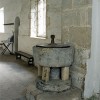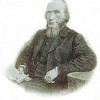One of Dorset’s Elizabethan gems is Kingston Maurward Manor, a rare E-plan house, of which only Parnham, Chantmarle and Anderson Manor bear some comparison. But the latter had their origins some one hundred years later than the manor at Maurward, so making its ground plan unique for the Dorset of its century.
It was in about 1597 that Christopher Grey, a descendant of a county family who had married into the Maurward family some two centuries earlier when they inherited the estate named after them, built the house in Maurward Park that would become known as The Old Manor. Little information about the building of this house has been handed down, and virtually nothing is known about where the Greys had been living up until then. However, it has been noted that a particular architectural detail of the house – window mullions with moulded bases – also occurs in Wolfeton House near Dorchester, suggesting that the same mason had been employed on both houses.
Angel Grey, grandson of Christopher, then built an extension onto the south-east side of the Old Manor early in the 17th century, though his reason for doing so is not exactly known. Three quarters of a century later in 1700 George Pitt married Laura Grey, a descendant of Angel, and they commissioned the building of a new house on a site across the park from the manor. This is now Kingston Maurward House.
Structurally, the attic of the Old Manor comprises eight great A-frames and some of these still bear numbers carved into them by the Tudor carpenters. The joists supporting the first and second floors are 15” x 15” oak beams. The house is entered through the middle wing of the west front, where the screens passage would originally have been. The Great Hall would have been off to the right with the Great Kitchen opposite, occupying the north wing of the ‘E’.
More recently the foundations of what appears to have been a staircase tower once occupying the space between the Tudor house and the Grey extension were discovered, though nothing else remains of the original tower today. Of course, there must have once been a means of access to the upper storeys which was later destroyed. As it happened Angel Grey, the builder of the 17th century extension, was a staunch Royalist, and it has been supposed that the destruction of the staircase occurred during the Civil War by a troop of local Roundheads, perhaps in an attempt to render the upper floors of the house uninhabitable.
By the time the new house built by Pitt in 1700 was completed the Old Manor had become subordinate and largely un-maintained as the estate then passed through other owners. Dorset County Council eventually bought this house in 1947 and converted it into five private residences for council tenants, but by the late 1950’s it had again fallen into disuse. By 1947 however, the new house had become the home of the county’s agricultural and horticultural college.
After the Old Manor had fallen derelict the County Council, with the support of the agricultural college, came to an agreement to have the building demolished, a decision which led to a public outcry. For a while nothing was done, but then a chance meeting at a London party between the manager of a Bedfordshire plastics company and the secretary of The Society for the Protection of Ancient Buildings proved to be the critical fulcrum.
Rohan Sturdy had a sound personal reason for being enthused by what he heard about Maurward Old Manor from the SPAB secretary. He belonged to a scion of the Sturdys of Trigon near Wareham and accordingly felt his roots to lie in Dorset.
Sturdy was then living in Bedfordshire to be near his business, but in 1962 Dorset County Council leased the manor to him at a peppercorn rent, in return for an obligation on his part to restore it. For the next six years until 1968 contractors were at work on restoring the house almost every day. Sturdy’s daughter, who had a second home at Lulworth, also threw herself into this labour of love, taking on an assistant supervisory role.
Upon completion a grateful County Council even granted Sturdy a freehold on the property, though the businessman never lived there himself; neither did his son, a farmer in Gloucestershire, when in turn the house was bequeathed to him. For the next decade the house would be sub-let to tenants before being privately sold to the predecessors of the present owners.
During its years of dereliction the Old Manor suffered extensive deterioration in its structure and ground management. When the work of restoration began most of the windows had lost their glass and floors had collapsed from being infested with death watch beetle. Outside, the peace of the grounds was disturbed by the sound of clucking and crowing from henhouses on an adjoining chicken farm.
In his restoration, sturdy incorporated imitations and fittings from other houses. For example, restoration of some of the panelling was modelled on original panelling in Stinsford Church. The 17th century stairway tower was restored, recycling masonry from a demolished Tudor house in Weymouth, while the re-installed spiral staircase, which comes into use on the 1st floor, is said to have been made from the timber of a single oak grown on the Trigon estate. Another staircase was brought from Haddon Hall in Suffolk and installed in a new hall built into the space formerly occupied by the screens passage and part of the Great Kitchen. Sturdy also converted much of what had been the Great Hall into an L-shaped drawing room in which the original Tudor fireplace was re-exposed after removing eight layers of lathe and plaster.
The remaining space – actually the ground floor of the north wing – is now a spacious comfortable dining room. The new kitchen was installed between the drawing room and the large room occupying most of the ground floor space in the Greys extension wing. Access to the drawing room is through an imposing archway that Sturdy called ‘Angels arch’. He further re-inforced some of the original oak beams with girders or steel cradles and installed several bathrooms.
Under the present owners the voluminous and long-deserted attics have been modernised, and one has been converted into a luxurious bed sitting room. Maurward Old Manor is now in the formative years of a new life as a guesthouse, with three superb bed-and-breakfast suites installed on the 1st floor. For one of these suites a custom designed and made four-poster bed in Elizabethan style was commissioned, reproducing the family crest of the Maurwards on one side and that of the Greys on the other. Rusting glazing bars in the windows have been replaced with ones made of stainless steel, and in the garden an Elizabethan yew hedge has been planted.
The Old Kingston Maurward Manor is therefore effectively an “Elizabethan” manor built in the 1960’s! And on inspection it would be hard to imagine a reproduction more faithful to the original anywhere. Under the present owners devoted labours it has been given a new lease of life, and one in which it is earning a living for itself. The Old Manor is indeed a credit to Maurward Park.



